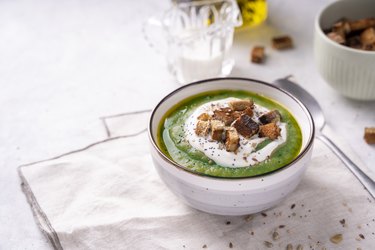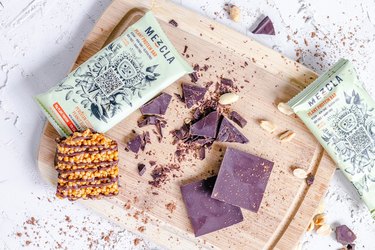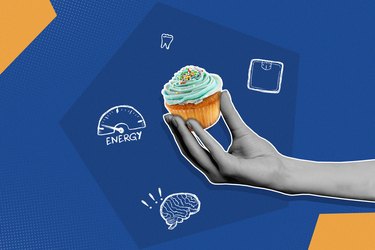Plain steamed crab meat is one of the healthiest seafoods you can eat. For very few calories, crab is a great source of protein. It also has a lot of minerals and B vitamins within it. If you are more likely to get heart disease, you might want to choose certain kinds of crab or limit the amount you eat. Some types of crab have more cholesterol or sodium than others.
Yes, crab meat is healthy! Its full of protein, as well as some essential vitamins and minerals. Be careful with your portions and don’t add too much butter or other high-fat or high-sodium sauces.
Raw crab meat is incredibly low in calories, and almost all of the calories come from protein. Blue crab meat offers just 74 calories from a 3-ounce cooked portion, according to USDA National Nutrient Database.
The same amount of Alaska king crab has about 71 calories, while a 3-ounce serving of Dungeness crab has almost 73 calories. Roughly 85 percent of those calories are from protein. The final percentage of calories are from fat and a small amount from the carbs in crab.
Avoid all that butter or cream sauce to keep your calories and fat to a minimum. According to the USDA National Nutrient Database, adding just one tablespoon of melted butter adds 100 calories. Almost all of those calories come from fat, mostly saturated fat.
Crab is a type of shellfish that has been enjoyed around the world for centuries. But is crab actually good for you, or is it unhealthy? With conflicting information online, many people are left wondering about the pros and cons of eating crab.
I did some extensive research on this topic using reputable sources like WebMD and Coopers Seafood House Here’s a comprehensive look at the health impacts – both good and bad – of eating crab
Potential Benefits of Eating Crab
While crab does have some drawbacks (which I’ll cover next), it also offers some great health benefits. Here are some of the main positives of incorporating crab into your diet:
High in Protein
Crab is an amazing source of protein. In fact, it contains almost as much protein per 100 grams as lean meats, with a 1 cup serving providing 24 grams. The protein in crab is highly digestible too. Getting enough protein ensures you maintain muscle mass, heal wounds, and keep your immune system strong.
Contains Omega-3s
Crab meat is high in omega-3 fatty acids like DHA and EPA. Omega-3s offer protection against heart disease, aid brain development and function, and may even inhibit aggressive behavior according to some studies. Crab contains the beneficial long-chain variety of omega-3s that are ready for our bodies to use immediately.
Excellent Source of Vitamin B12
Vitamin B12 is necessary for healthy blood and preventing anemia. It also helps maintain brain and nerve function. Crab contains sizable amounts of B12, with 100 grams providing over 300% of your recommended daily value.
Rich in Selenium
Selenium supports thyroid health, boosts immunity, and acts as an antioxidant. Crab has very high selenium levels – over 100% of your daily needs in just 100 grams.
Provides Folate, Niacin, Zinc
In addition to the nutrients already mentioned, crab contains useful amounts of folate, niacin, zinc, and other vitamins and minerals. Folate aids healthy cell growth and niacin supports metabolism.
May Protect Brain Health
Some research indicates that people who eat crab and other seafood at least once a week have reduced risk of dementia, Alzheimer’s disease, and other age-related cognitive decline. The omega-3s in crab may be key contributors to this brain-boosting effect.
So in terms of nutritional benefits, crab can clearly give your health a nice boost! Now let’s look at some of the potential downsides of eating crab.
Potential Downsides of Eating Crab
Although it provides ample nutrition, crab does come with some cautions as well. Here are a few of the key drawbacks to be aware of:
High Sodium Content
Like most seafood, crab tends to be high in sodium. A 3-ounce serving contains over 350 milligrams of sodium, which is 15% of the recommended daily limit. Consuming too much sodium can increase blood pressure and heart disease risk, so this is something to watch if you eat crab frequently.
Risk of Heavy Metal Exposure
Crabs can accumulate heavy metals like mercury in their tissues, so overconsumption may lead to excessive exposure. Opting for low mercury crab varieties like Atlantic Blue Crab can help reduce this risk. You can also limit intake to suggested amounts of 8-12 ounces of seafood weekly.
Potential Cadmium Contamination
Brown crab meat is prone to cadmium contamination. Cadmium is a heavy metal that is toxic in high doses. To limit exposure, stick to eating the white crab meat and avoid brown meat, roe, and crab hepatopancreas.
Allergies
Some people are allergic to crab and need to avoid it entirely. Allergic reactions can range from mild nausea, hives, and stomach pain to severe anaphylaxis. People with known shellfish allergies should not consume any crab.
Choking Hazard
Crab legs, shells, and other body parts can pose a choking risk, especially for children and people with swallowing disorders. Make sure to pick out shells and fully chew crabmeat to prevent choking incidents.
So while crab offers nutritional perks, there are some potential drawbacks to consider too. Moderation and smart preparation are key to safely enjoying crab and avoiding any pitfalls.
Tips for Choosing Healthy Crab Products
If you want to gain the benefits of crab while minimizing risks, follow these simple tips when shopping and eating crab:
-
Opt for fresh crab whenever possible instead of imitation crab meat which is highly processed.
-
Look for sustainably harvested crabs like Atlantic Blue Crab or Dungeness Crab.
-
Avoid crabs from contaminated waters that may contain excess mercury or other pollutants.
-
Pick canned crab that is low sodium or sodium-free. Rinse canned crab before use to further reduce sodium.
-
Eat white crab meat rather than brown meat or roe to limit cadmium exposure.
-
Remove the crab hepatopancreas (“mustard”) which accumulates toxins.
-
Enjoy crab in moderate portions of about 3-4 ounces at a time.
-
Carefully remove shells and cartilage to prevent choking hazards.
Following these tips when selecting, preparing, and eating crab can help you avoid potential issues while still benefiting from its nutritional value.
Healthy Ways to Eat Crab
Wondering how to work more crab into your diet? Here are some delicious and nutritious recipe ideas:
Crab Cakes
Make traditional crab cakes using fresh lump crabmeat, breadcrumbs, egg, and spices. Bake instead of fry for a healthier option. Serve with homemade aioli or remoulade sauce.
Crab Salad
Combine crabmeat with diced celery, lemon juice, light mayo, Dijon, and fresh herbs. Scoop the crab salad onto greens or stuff into tomatoes for a tasty, protein-packed meal.
Thai Crab Salad
For a Thai twist, create a salad with crab, shredded cabbage and carrots, cilantro, mint, sliced almonds, and Thai peanut dressing.
Crab Soup
Simmer diced potatoes, corn, onion, and crabmeat in broth with Old Bay seasoning for a hearty crab soup. Garnish with fresh parsley.
Crab Legs
Steam Alaskan King crab legs and dip in melted butter. Pair with grilled lemons and a side of roasted asparagus.
You can also add crabmeat to pasta, stir fries, frittatas, and more to give dishes a protein and nutrition boost. Just use high quality, fresh crab and limit portions to about 3-4 ounces.
The Verdict: Is Crab Good or Bad For You?
So what’s the final consensus – is crab good or bad for your health?
Overall, research shows that eating moderate amounts of crab as part of a balanced diet is perfectly healthy for most people. In fact, crab provides a nutritional package of protein, omega-3s, vitamin B12, selenium and other important nutrients that can benefit your wellbeing.
However, issues like sodium content, heavy metal accumulation, allergies, and choking hazards need to be considered. By following safe preparation and portion control, you can gain the most benefits from crab while avoiding potential downsides.
Here’s a quick summary:
The Pros of Eating Crab
-
Excellent source of protein, omega-3s, B12, selenium
-
May boost heart health, brain function, immunity
The Cons of Eating Crab
-
High in sodium
-
Potential for heavy metal exposure
-
Allergy risks
-
Choking hazards from shells and cartilage
The Verdict: Enjoying fresh crab 1-2 times per week as part of a varied diet is perfectly healthy for most people. But be mindful of portion sizes and preparation methods for maximum safety and nutritional benefits.
So go ahead and work some crab into your meal plan to take advantage of the impressive protein, omega-3s, and other nutrients it offers! Just be sensible about quantities and follow general seafood safety guidelines. Aim for 8-12 ounces of a variety of seafood per week as recommended, including moderate portions of crab.

Cholesterol in Crab Meat
Some consumers may worry about crab meats cholesterol content. Our 2015–2020 Dietary Guidelines say that you shouldn’t have more than 300 milligrams of cholesterol a day, or no more than 200 milligrams if your blood cholesterol is already high.
The amount of cholesterol in three ounces of steamed blue crab is over 66 milligrams. The amount of cholesterol in three ounces of Dungeness crab is about 56 milligrams. Youll get just 36 milligrams of cholesterol from a 3-ounce cooked portion of Alaska king crab.



High in Saturated Fat
Low-density lipoprotein levels can go up a little if you eat too much cholesterol, but cholesterol in food doesn’t always do that. In addition to having too much cholesterol, eating a lot of saturated fat can cause your bad LDL cholesterol to rise.
Less than 10 percent of your calories, or 7 percent for optimal heart health, should come from saturated fat, as reported in 2015–2020 Dietary Guidelines for Americans. Based on 2,000 calories daily, thats a maximum of either 22 grams or 15 grams. So while raw crab meat is slightly high as far as cholesterol content, it doesnt have much saturated fat. Three ounces of most varieties of steamed crab offer less than 0.2 gram of saturated fat.
Read more: Imitation Crab Meat Nutrition
Pros and Cons of Crab Meat
What happens if you eat too much crab meat?
Too much sodium can increase your risk of stroke, heart disease, high blood pressure and congestive heart failure. The same serving of crab meat contains 45 milligrams of cholesterol. Consuming too much cholesterol can increase your risk of heart disease, heart attack and stroke.
Is brown crab bad for You?
Brown crab meat can also have high levels of cadmium, which is toxic if you take in too much. Crab also has a good bit of sodium (376 mgs in a 3-ounce portion). If you’re hungry for seafood, but want a little less sodium, great choices include: Find out what the research says about crab, who should avoid it, and how it may affect your health.
Is crab meat healthy?
Yes, crab meat is healthy! It’s full of protein, as well as some essential vitamins and minerals. Just make sure you watch your portion sizes and aren’t drowning it in butter or other high-fat or high-sodium sauces. Raw crab meat is incredibly low in calories, and almost all of the calories come from protein.
Does crab meat raise cholesterol?
A heart-healthy diet is low in both dietary cholesterol and saturated fat. Although crab meat and shrimp do contain cholesterol, they might not have an overly large effect on your cholesterol levels if you eat them in moderation. When it comes to raising your cholesterol levels, saturated fat content is much more important than dietary cholesterol.
